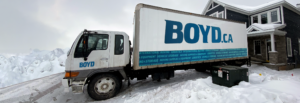Ultimate Survival Guide: Moving in the Winter
As the days start getting longer, and the ice begins to melt away, all Ottawans are feeling hopeful that spring is right around the corner. However, even if the groundhog predicted an early spring, the weather in Ottawa doesn’t always want to cooperate. From freezing rain to blizzards, Mother Nature keeps a tight grip on our winter weather for as long as she possibly can.
There is no doubt that moving in the winter is a challenge. Just because the weather is a disaster, doesn’t mean your move needs to be. Whether you’re going across town or across the country, moving can seem like a huge chore. Adding “deal with winter weather” to your never ending to-do list could push you over the edge.
To make your winter move as hassle-free and safe as possible, we’ve compiled an ultimate survival guide with all the tips you need to know. Here’s to ensuring that your belongings reach their next destination safely and efficiently this winter.
Winter Moving Tips
#1: Be Flexible
One of the key ways to survive a winter move is to have an open-mind. If possible, be flexible on moving dates to keep things as stress-free as possible. We all know how unexpectedly the weather can turn, so having a back-up plan is a great idea.
If you’ve hired a moving company and are traveling a long distance, bad weather can delay the arrival of your belongings to your new home. Make sure you’re prepared to wait a day or two in your new home without the moving truck – just in case.
#2: Don’t Pack Essentials
Pre-packing can make things easier on the day of the move, but there are some essentials you’ll want to leave out until the very end. Keep your coffee maker or kettle handy for hot drinks on the day of the move, and keep your winter driving essentials readily available for the commute. Things like a small shovel, your windshield scraper, and extra gloves should be easily reachable in your car.
We also suggest keeping a suitcase of essential clothing, blankets and toiletries in the event your move is delayed.
#3: Safety First
Make sure your pack up and unload locations are safe for you and the movers, as well as protected from the elements. Ensure driveways, steps, and walkways are clear of ice and snow, and throw down salt if necessary.
At the new home, make sure any necessary utilities are turned on prior to your arrival – heat, water, and electricity but consider lowering the heat, or turning it off altogether while moving in as heat will be lost through the open doors.
#4: Start Early
As a rule of thumb, plan for everything to take longer than you expect. Even with clear weather, winter conditions will slow things down: everything from loading and unloading to commuting between locations. Start early in the day to make the most out of limited daylight and avoid working on icy surfaces in the dark. As a bonus, temperatures should be more comfortable throughout the day than in the evening as well, making the whole moving experience (slightly) more enjoyable.
#5: Prepare for the Cold
It may sound obvious but, for both you and your belongings, make sure to protect against colder temperatures. Dress in layers to keep warm. Layers will also allow you to easily remove pieces of clothing as you warm up throughout the day.
You’ll also want to make note of any items that may be affected by the cold temperatures, such as electronics or glassware. Load boxes with glassware last to avoid having them sit in the cold for too long, and consider transporting electronics in your own vehicle.
#6: Protect your Home
Protecting your floors should also be a top priority. Lining your floors with runners, plastic sheets, or old towels will protect them from any dirt, rocks, or melting snow that makes their way inside. After all, the last thing you’d want in your new home are wet, salt-stained hardwood floors.
#7: Consider Tents
If you have a long driveway, it may be worthwhile to put up party tents for extended coverage. Using shelter during your move completely seals off the area from snow and rain, ensuring an even faster move. Now your boxes will be protected from whatever Mother Nature throws your way.
#8: Invest in Moving Containers
Moving long-distance? Packing your belongings in a steel moving container can keep them safe from the harsh weather. Boyd makes it easy, our containers are water and leak-proof, perfect for those relentless Canadian winters. [link to https://boydmoving.com/storage/shipping-containers-diy-storage/ page] Renting our weatherproof containers means you can leave them out overnight if need be. Nights come quickly in the winter, if you’re done for the day, you can rest assured that your belongings are safe and sound.
#9: Gather your Winter Supplies
We know you already have so many things to remember when packing up your home. From purchasing packing supplies to going through your belongings, your head probably feels like it’s about to explode. However, we encourage adding one last note to your to-do list: gather and organize your winter supplies.
Given winter weather’s unpredictability, you’ll want to be ready whatever comes your way on moving day. You may need shovels to dig out your front steps, and salt or sand to prevent your driveway from turning into a skating rink. A small space heater may even be a good idea for your entryway, especially during a deep freeze.
#10: Keep an Eye on the Weather
On the days leading to your move, you’ll want to keep your phone’s weather app handy. That way you can plan accordingly for whatever the weather gods send your way. We recommend that you set a reminder on your phone to check the forecast at least a week before your moving date. Then continue to revisit the forecast daily, that way you can be prepared for snow, ice, rain or freezing rain.
It’s smart to also ask when you receive a moving quote if your movers have any weather hindrances or rescheduling policies for inclement weather. That way everyone is on the same page, even if Mother Nature wants to throw a curveball on moving day.
Benefit of Moving in the Winter
Once warm, sunny days are upon us, the increase in movers and demand will be much higher. June through September is the busiest time of the moving year. Due to a high demand and lower supply, moving costs go up during these months. This means that you can easily save some of your hard-earned money by planning your move during the winter months.
If you are in a position to choose the time-period of your move, we encourage everyone to consider moving in the winter months. Not only will you save some money, but you can have bragging rights for surviving a move under the toughest of conditions.
We Keep Ottawa Moving
Moving in the winter can certainly have its challenges, but by being prepared for the elements and staying flexible, you can make the process run smoothly, safer and with less stress. Following these winter moving tips means that in no time, you’ll have your feet up relaxing in your new space, away from the elements!
If you have a move coming up this winter and need help packing or moving, contact us today for a hassle-free moving quote.

















